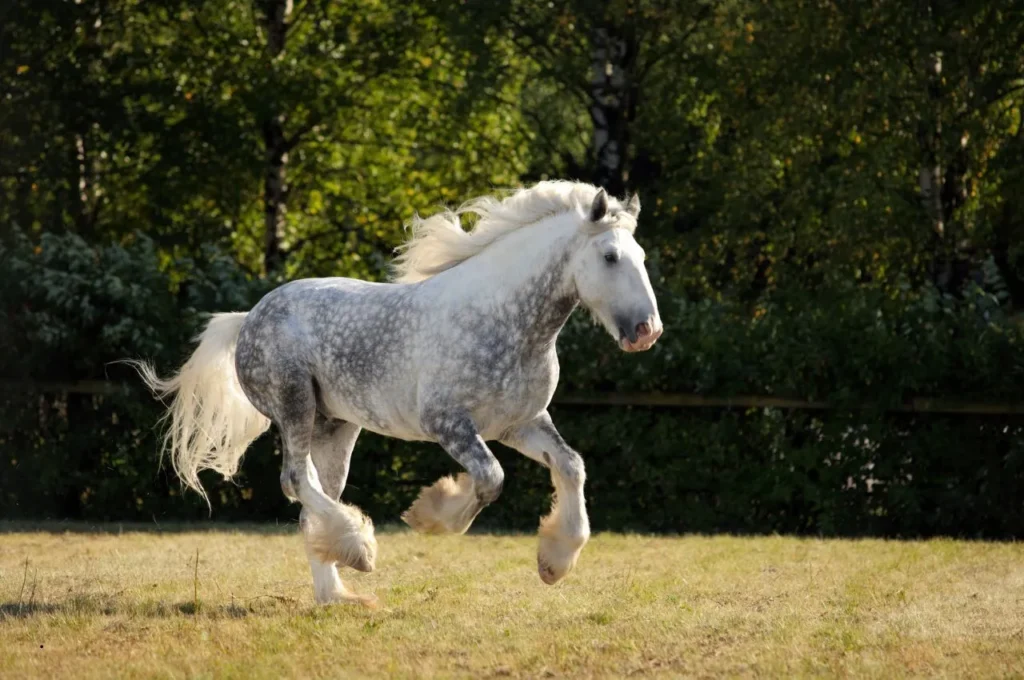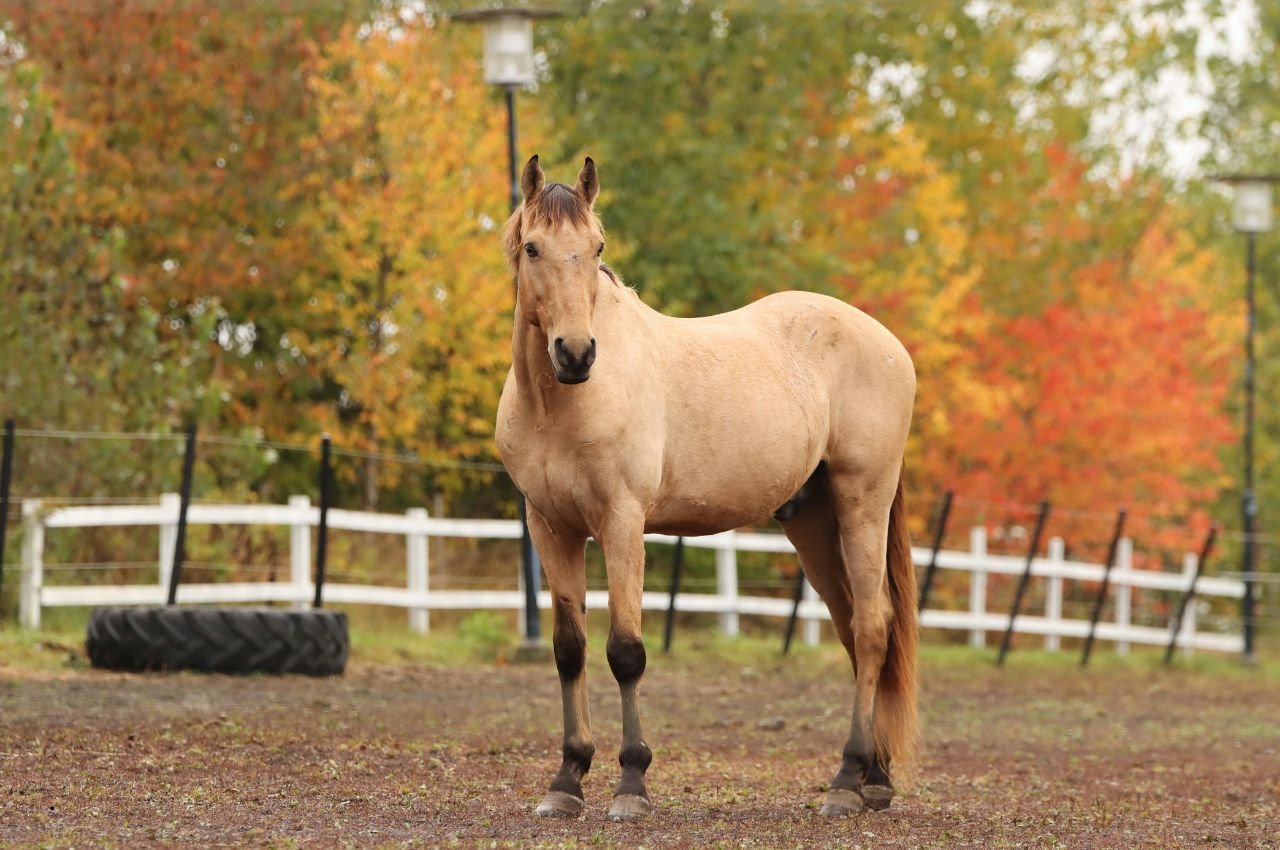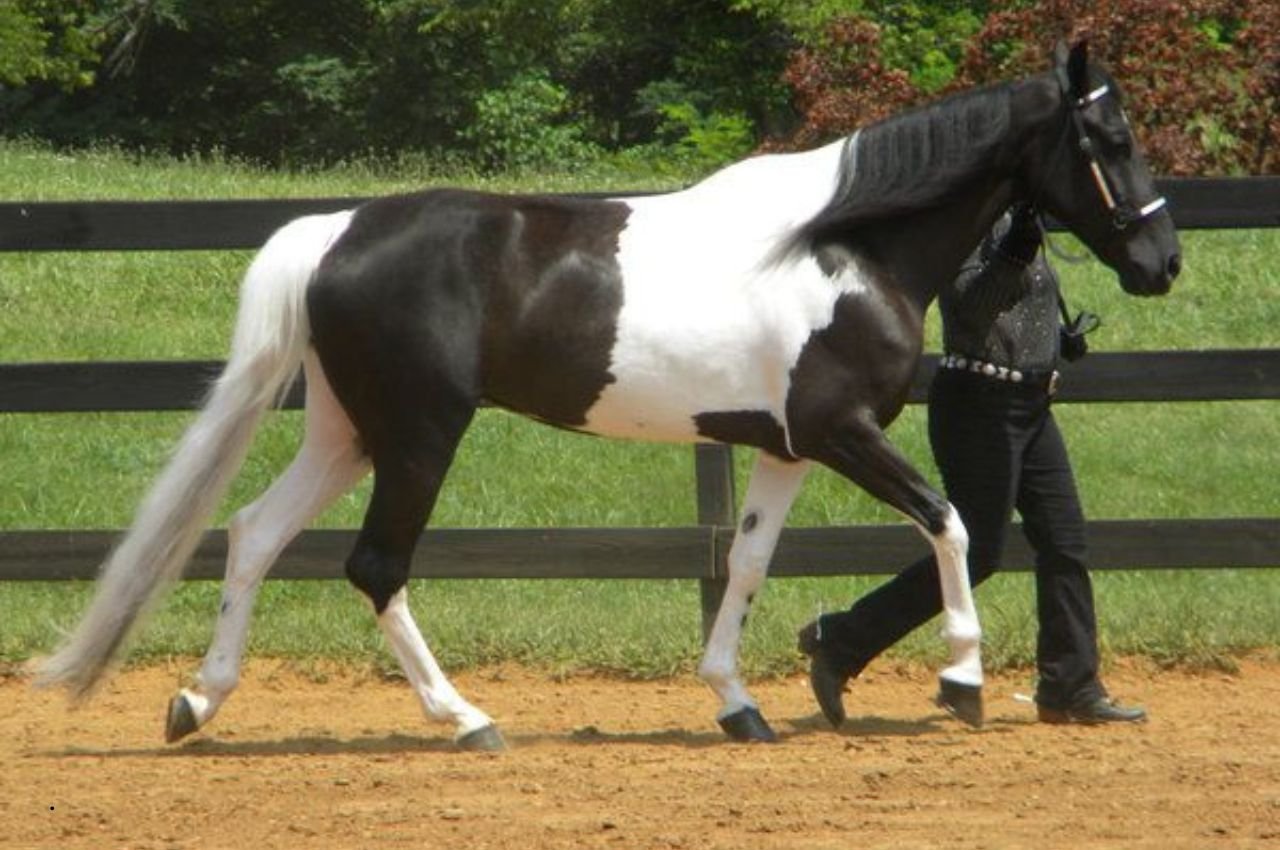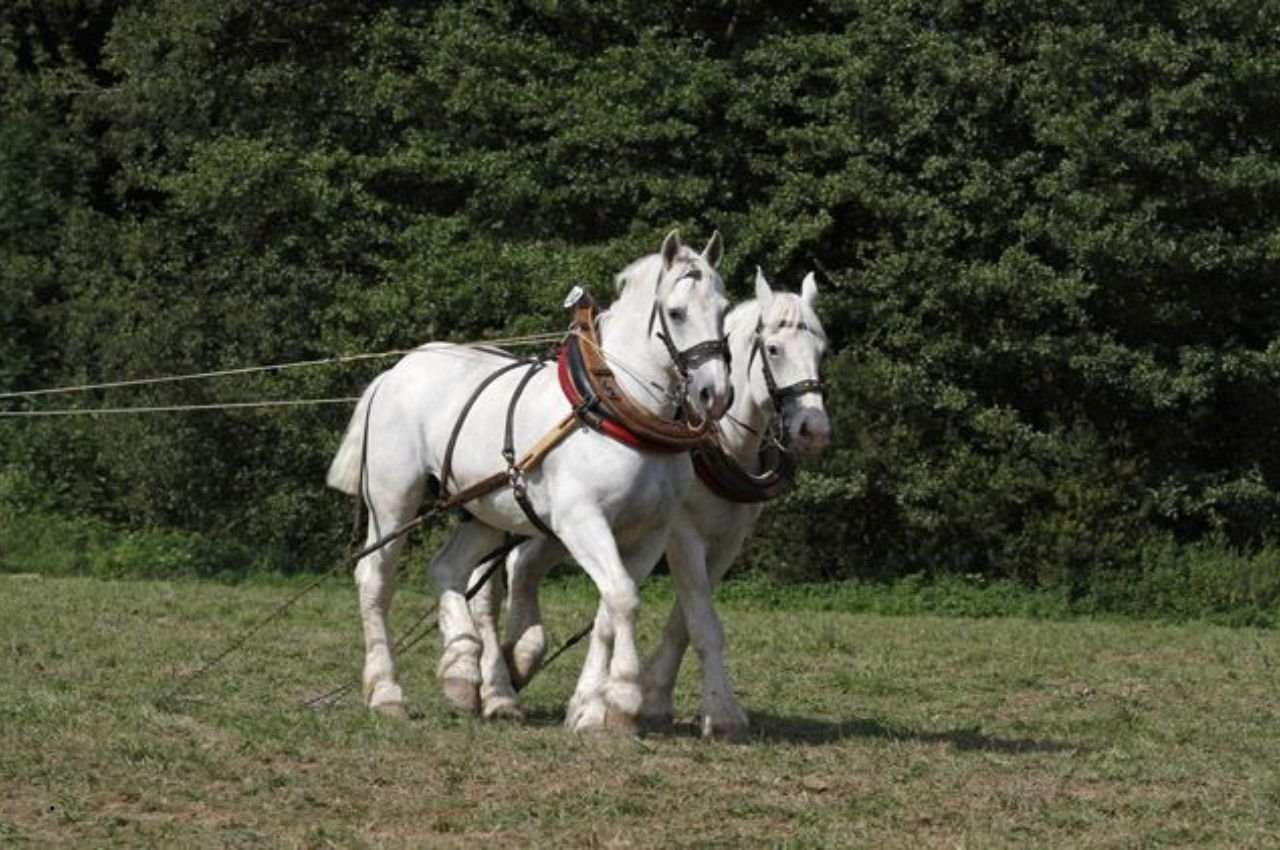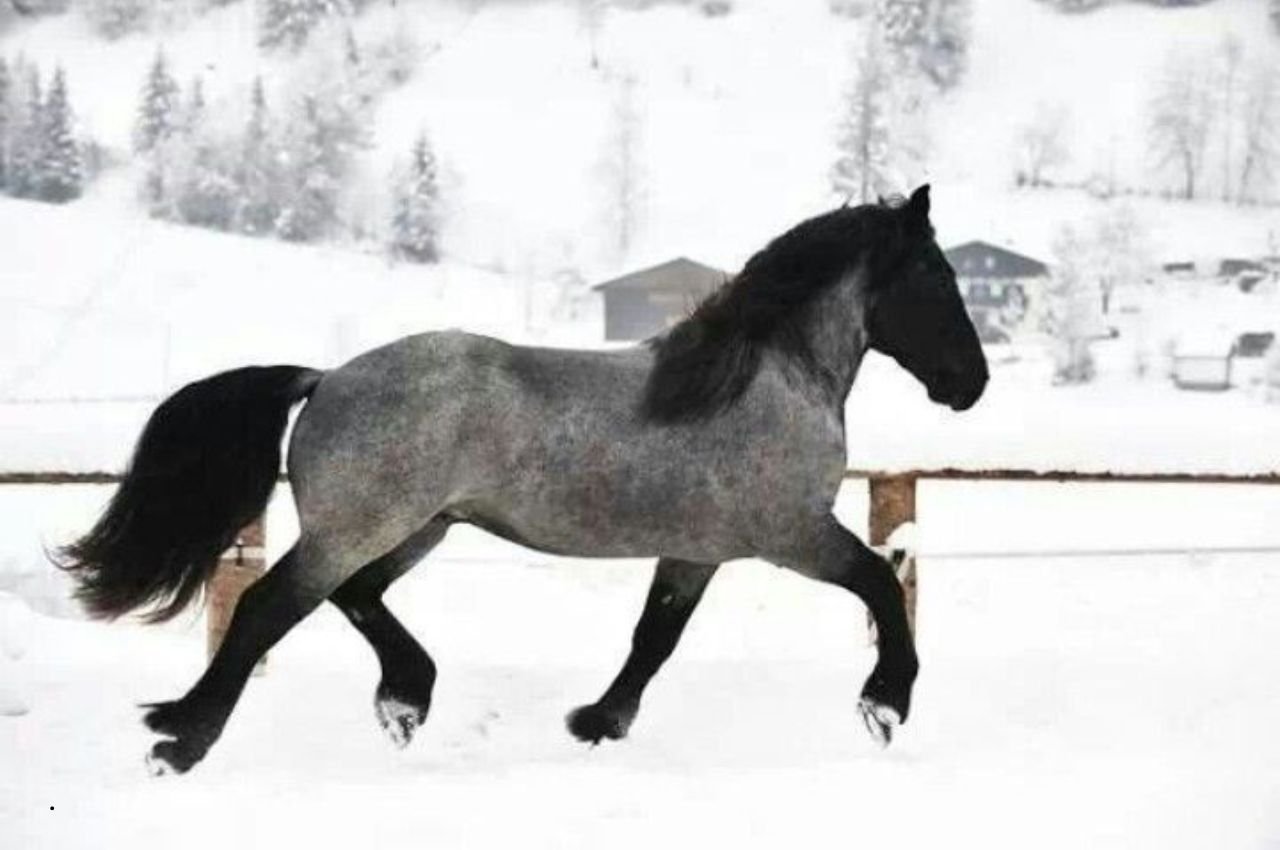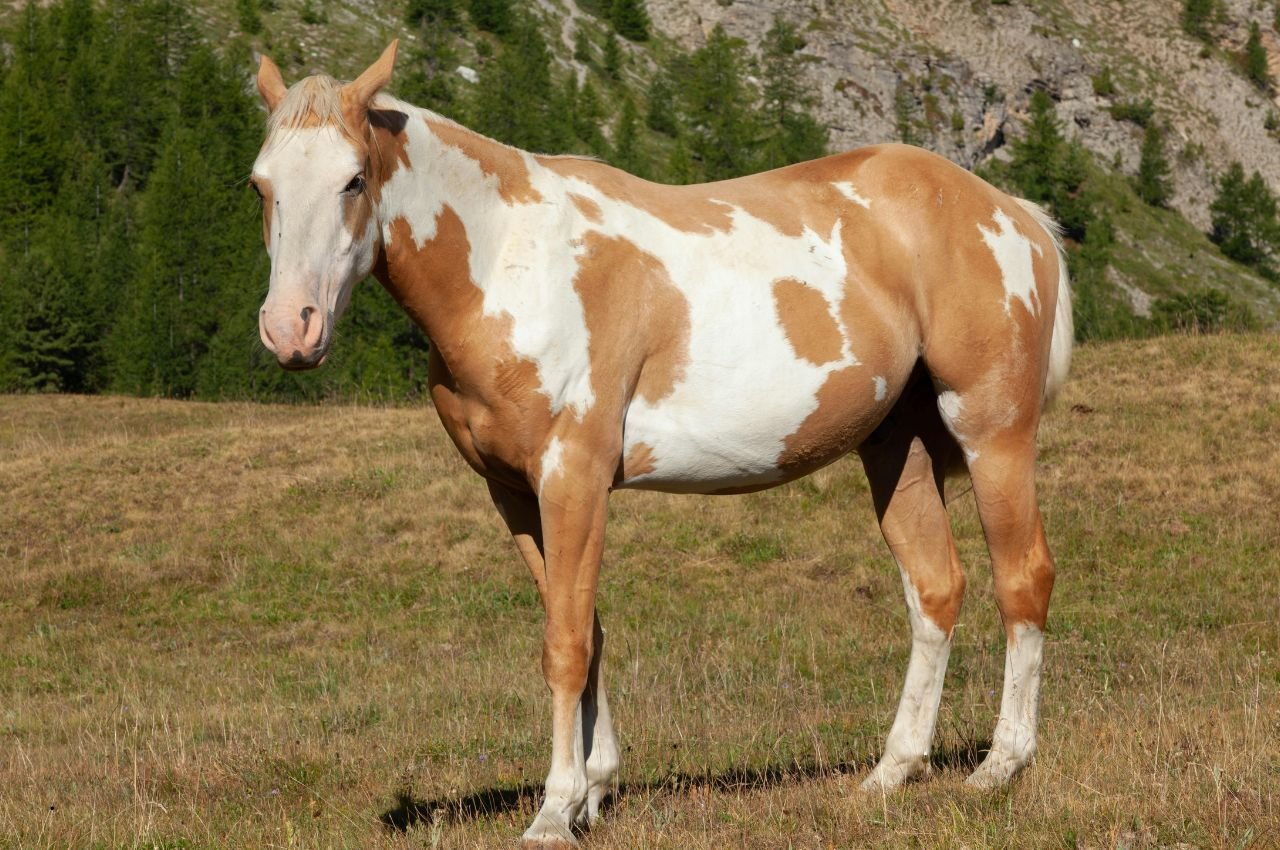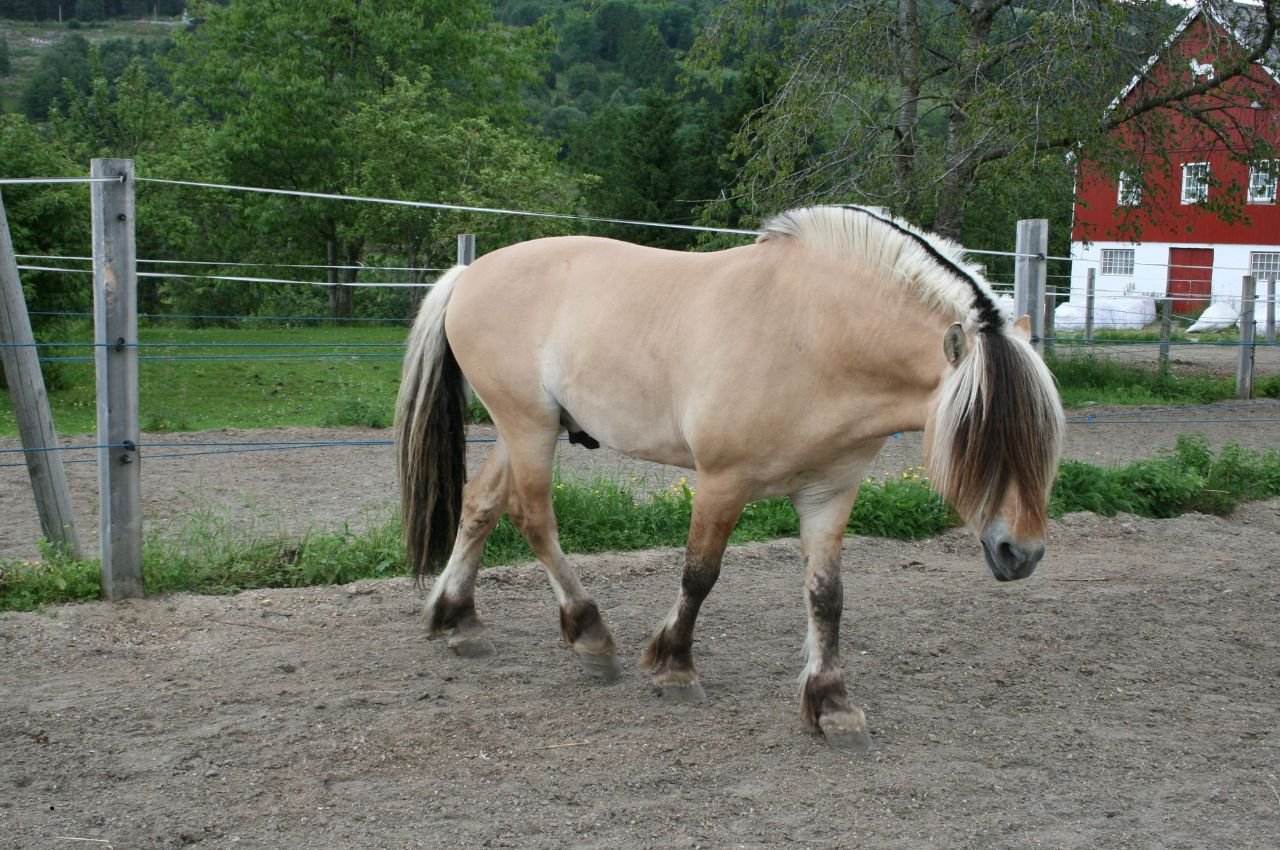The Shire horse stands as one of the most magnificent and powerful horse breeds in the world, capturing hearts with their gentle nature and impressive stature. These gentle giants have played a crucial role in agricultural and industrial history, and today they continue to enchant horse enthusiasts worldwide with their remarkable characteristics and versatile abilities.
History and Origins
The Shire horse originated in England during the medieval period, with roots tracing back to the Great Horse or War Horse of the Middle Ages. These massive steeds were initially bred to carry knights in full armor into battle, requiring immense strength and stamina. The breed’s development accelerated during the 18th and 19th centuries when they became essential for agricultural work and hauling heavy loads in Britain’s growing industrial economy.
The breed’s name “Shire” comes from the English shires (counties) where they were predominantly bred, particularly in Lincolnshire, Cambridgeshire, Huntingdonshire, and Northamptonshire. The Shire Horse Society, established in 1878, helped standardize the breed and maintain detailed breeding records, making it one of the oldest horse breed registries in the world.
During the Industrial Revolution, Shire horses were the backbone of transportation and agriculture. Breweries, particularly, favored these horses for delivering beer barrels through city streets. The famous Budweiser Clydesdales, while a different breed, represent this same tradition of draft horses in commercial use.
Physical Characteristics
Size and Build
Shire horses are renowned for being among the largest horse breeds in the world. Stallions typically stand between 17 to 19 hands high (68-76 inches at the withers), while mares are slightly smaller at 16 to 18 hands. Their weight ranges from 1,800 to 2,400 pounds, with some exceptional individuals reaching even greater proportions.
Size Comparison Chart
| Measurement | Stallions | Mares | Geldings | Comparison | |—
References and Sources
- Shire Horse Society – Official UK breed registry and conservation organization
- American Shire Horse Association – North American breed registry
- The Livestock Conservancy – American livestock breed conservation organization
- Rare Breeds Survival Trust – UK rare breed conservation charity
- Shire Horse Society of Australia – Australian breed registry and promotion
- Wikipedia: Shire Horse – Comprehensive breed information
- Guinness World Records – Sampson (Mammoth) tallest horse record
- Essex Shire Horse Association – Regional breed promotion
Additional Useful Resources
- The Livestock Conservancy Endangered Equine Alliance – Conservation efforts for rare horse breeds
- South Wales Shire Horse Society – Regional breed organization
- Conservation Priority List – Breed conservation status classifications
Veterinary and Care Resources
For specific veterinary care and health management, consult with equine veterinarians experienced in draft horse breeds. Many universities with veterinary programs maintain equine extension services with educational materials on draft horse care.
Additional information compiled from veterinary sources, breed registries, and equine care publications.
————-|———–|——-|———-|————| | Height | 17-19 hands | 16-18 hands | 16.5-19 hands | Average horse: 14-16 hands | | Weight | 1,900-2,400 lbs | 1,700-2,200 lbs | 1,800-2,300 lbs | Average horse: 900-1,200 lbs | | Chest Girth | 84-96 inches | 80-92 inches | 82-94 inches | Average horse: 70-76 inches | | Cannon Bone | 9-11 inches | 8.5-10 inches | 9-10.5 inches | Average horse: 7-8 inches |
The world record for the tallest horse ever recorded was held by a Shire horse named Sampson (later renamed Mammoth), who stood 21.2½ hands high (7 feet 2.5 inches) and weighed 3,360 pounds. He was bred by Thomas Cleaver of Toddington Mills, Bedfordshire, UK, and foaled in 1846.
Body Structure
Shire horses possess a powerful, muscular build with several distinctive features:
Head and Neck: They have a noble head that’s proportionate to their large body, with a straight or slightly Roman nose profile. Their eyes are kind and intelligent, typically dark in color. The neck is strong, well-arched, and muscular, providing the power needed for heavy draft work.
Body: The chest is broad and deep, providing ample room for large lungs and heart. Their back is relatively short and strong, with well-sprung ribs and a deep girth. The croup is long, wide, and gently sloping.
Legs and Feet: Perhaps their most distinctive feature is their legs, which are heavily muscled with substantial bone structure. The lower legs are covered in long, silky hair called “feather,” which extends from below the knee and hock down to the hooves. Their feet are large, round, and well-formed to support their massive weight.
Coat Colors
Shire horses come in several accepted colors:
- Black: The most traditional and common color
- Bay: Ranging from light to dark bay
- Brown: A rich, dark brown shade
- Grey: From light grey to dapple grey
- Chestnut: Less common but acceptable
White markings are common and often extensive, particularly on the legs and face. These markings, combined with the feathering, give Shire horses their distinctive appearance.
Temperament and Characteristics
Despite their imposing size, Shire horses are renowned for their gentle, docile temperament. They are often described as “gentle giants” due to their calm, patient, and willing nature. Shire horses are an easygoing breed that is hard working and easy to train. They are a good breed for all levels of owners – even beginners. They are good around other animals, even dogs, and loud noises, cars, and even children do not upset them. Key personality traits include:
Intelligence and Trainability
Shire horses are highly intelligent and eager to please, making them relatively easy to train despite their size. They respond well to consistent, patient training methods and form strong bonds with their handlers. Their intelligence makes them versatile workers capable of learning complex tasks.
Gentle Nature
These horses are known for their patience and tolerance, particularly around children and inexperienced handlers. Their calm demeanor makes them excellent candidates for therapeutic riding programs and educational demonstrations.
Work Ethic
Bred for centuries as working horses, Shires have an inherent strong work ethic. They are willing workers who take pride in their tasks, whether pulling heavy loads or performing in shows.
Social Behavior
Shire horses are naturally social animals that thrive in herds. They establish clear hierarchies but are generally peaceful with other horses. Their size often makes them natural leaders in mixed groups.
Care Requirements
Feeding and Nutrition
Caring for a Shire horse requires understanding their substantial nutritional needs:
Daily Feeding Requirements Chart
| Feed Type | Amount per Day | Percentage of Body Weight | Notes |
| Hay | 25-40 lbs | 1.5-2.0% | Primary roughage source |
| Grain/Concentrates | 8-16 lbs | 0.5-1.0% | Adjust based on work level |
| Water | 10-12 gallons | – | More in hot weather |
| Supplements | As directed | – | Joint, hoof, vitamin support |
Nutritional Breakdown by Activity Level
| Activity Level | Hay (lbs/day) | Grain (lbs/day) | Total Daily Cost* |
| Maintenance | 25-30 | 4-6 | $8-12 |
| Light Work | 28-35 | 6-10 | $10-15 |
| Moderate Work | 30-38 | 8-12 | $12-18 |
| Heavy Work | 35-40 | 12-16 | $15-22 |
*Based on average feed costs – varies by region
Feed Quality Requirements:
- Hay Quality: High-quality grass hay or mixed hay should form the foundation of their diet. Timothy, orchard grass, and brome hay are excellent choices.
- Grain and Concentrates: Commercial draft horse feeds or a combination of oats, barley, and corn can provide necessary energy. The amount should be adjusted based on work level and body condition.
- Supplements: Due to their size, Shires may benefit from joint supplements containing glucosamine and chondroitin. Biotin supplements can help maintain healthy hooves.
Grooming and Maintenance
Daily Grooming: Regular brushing helps maintain their coat and allows for health monitoring. Pay special attention to the feathering on their legs, which can trap dirt and moisture.
Feather Care: The long hair on their legs requires daily attention. Use a wide-toothed comb or brush to prevent matting, and ensure the area stays clean and dry to prevent skin conditions.
Hoof Care: Their large hooves need daily picking and cleaning. Professional farrier care every 6-8 weeks is essential, with special attention to proper trimming and shoeing for their size.
Bathing: Regular baths help maintain skin health, particularly in areas where the heavy feathering might trap moisture and debris.
Housing and Environment
Shelter: Shire horses need substantial shelter that can accommodate their size. Stall dimensions should be at least 14×14 feet, with 10-foot ceiling height.
Fencing: Strong, safe fencing is crucial. Board fencing or heavy-duty wire mesh is recommended, as their size and weight can damage lighter fencing materials.
Pasture: Adequate pasture space is important, with approximately 2 acres per horse recommended, though this can vary based on grass quality and climate.
Health Considerations
Common Health Issues
Health Issue Risk Assessment
| Health Condition | Risk Level | Age of Onset | Prevention/Management |
| Chronic Progressive Lymphedema (CPL) | High | 2-10 years | Daily leg care, dry environment |
| Polysaccharide Storage Myopathy (PSSM) | Medium | 3-15 years | Genetic testing, diet management |
| Shivers | Medium | 5-15 years | Exercise management, support care |
| Joint Issues/Arthritis | High | 8-20 years | Weight management, exercise |
| Founder/Laminitis | Medium | Any age | Proper diet, hoof care |
| Respiratory Issues | Low-Medium | 10-20 years | Dust-free environment |
Chronic Progressive Lymphedema (CPL): This condition affects the lower legs and is more common in heavily feathered breeds like Shires. Shires have been identified to be at risk for chronic progressive lymphedema, a chronic progressive disease that includes symptoms of progressive swelling, hyperkeratosis, and fibrosis of distal limbs.
Polysaccharide Storage Myopathy (PSSM): A genetic muscle disorder that can affect draft breeds, causing muscle stiffness and pain.
Shivers: A neurological condition that causes involuntary muscle tremors, particularly in the hind legs.
Joint Issues: Due to their size and weight, Shires may be prone to arthritis and other joint problems, especially as they age.
Founder/Laminitis: Their heavy weight can predispose them to hoof problems, particularly if diet and management aren’t carefully monitored.
Preventive Care
Annual Health Care Schedule
| Month | Care Required | Estimated Cost | Notes |
| January | Dental exam, vaccinations | $200-400 | Start year with full exam |
| March | Deworming, body condition check | $50-100 | Pre-breeding season |
| May | Farrier, routine vet check | $150-250 | Prepare for active season |
| July | Vaccinations (if required) | $100-200 | Regional requirements |
| September | Deworming, winter prep | $50-150 | Assess nutritional needs |
| November | Dental check, blanket fit | $150-300 | Winter preparation |
Regular Veterinary Checkups: Annual health examinations are crucial, with particular attention to heart, respiratory, and musculoskeletal systems.
Vaccination Schedule: Follow standard equine vaccination protocols for tetanus, influenza, rhinopneumonitis, and other regional diseases.
Deworming: Regular fecal testing and strategic deworming help maintain digestive health.
Weight Management: Monitoring body condition is crucial, as excess weight can exacerbate joint and hoof problems.
Training and Exercise
Exercise Needs
Despite their calm nature, Shire horses need regular exercise to maintain physical and mental health:
Daily Movement: At minimum, they should have several hours of turnout or light exercise daily.
Conditioning: For working horses, gradual conditioning programs help build stamina and prevent injury.
Mental Stimulation: These intelligent horses benefit from varied activities and training challenges.
Training Considerations
Ground Training: Due to their size, solid ground manners are essential for safety. They should learn to lead respectfully, stand for grooming, and respond to voice commands.
Driving Training: Many Shires excel at driving, whether single or in teams. Professional training is recommended for this specialized skill.
Riding Training: While primarily draft horses, many Shires can be trained for riding, though their size requires experienced handlers.
Uses and Activities
Traditional Uses
Agricultural Work: Shire horses continue to work on farms, particularly in sustainable agriculture operations where their gentle impact on soil is valued.
Logging: In forestry operations, they provide an environmentally friendly alternative to machinery in sensitive areas.
Commercial Driving: Some breweries and tourist operations still use Shire horses for promotional purposes and authentic experiences.
Modern Applications
Showing: Shire horses compete in various classes including halter, driving, and performance events at breed shows and county fairs.
Therapeutic Programs: Their gentle nature makes them excellent therapy horses for individuals with disabilities or emotional challenges.
Education: Many farms and equine centers use Shires for educational programs about agricultural history and horse care.
Pleasure Driving: Many owners enjoy recreational driving, from quiet country roads to competitive combined driving events.
Riding: Some Shires are trained for riding, offering a unique experience for those who appreciate their smooth gaits and gentle nature.
Breeding and Genetics
Breeding Considerations
Breeding Shire horses requires careful consideration of several factors:
Genetic Health: Testing for hereditary conditions like PSSM helps ensure healthy offspring.
Conformation: Breeding should aim to maintain the breed’s characteristic features while improving overall health and soundness.
Size Management: While size is important, breeding for extreme height can lead to structural problems.
Temperament: Maintaining the breed’s gentle, willing nature is crucial for their continued success.
Breeding Process
Mare Selection: Mares should be of good conformation, proven health, and excellent temperament.
Stallion Choice: Stallions should complement the mare’s strengths and help address any weaknesses.
Pregnancy Management: Due to their size, pregnant mares need careful monitoring and adequate nutrition.
Foaling: Professional veterinary assistance is often recommended due to the size of both mare and foal.
Economic Considerations
Initial Costs
| Cost Category | Price Range | Notes |
| Purchase Price | $2,000 – $20,000 | Varies by age, training, bloodlines |
| Transportation | $500 – $2,000 | Depends on distance and equipment needed |
| Initial Equipment | $1,500 – $5,000 | Tack, grooming supplies, safety gear |
| Shelter Setup | $5,000 – $25,000 | New construction or modifications |
Annual Operating Costs
| Expense Category | Annual Cost | Monthly Cost | Notes |
| Feed (Hay & Grain) | $2,000 – $4,000 | $165 – $335 | Based on local prices |
| Veterinary Care | $500 – $1,500 | $40 – $125 | Routine care only |
| Farrier Services | $1,200 – $2,400 | $100 – $200 | Every 6-8 weeks |
| Insurance | $300 – $800 | $25 – $65 | Optional but recommended |
| Supplements | $200 – $500 | $15 – $40 | Joint support, vitamins |
| Total Annual Cost | $4,200 – $9,200 | $350 – $765 | Excluding emergency care |
Cost Comparison: Shire vs Other Breeds
| Breed Type | Annual Feed Cost | Size Factor | Special Needs |
| Shire Horse | $2,000 – $4,000 | 1.5-2x standard | Heavy feathering care |
| Average Light Horse | $1,500 – $2,500 | Standard | Basic grooming |
| Pony | $800 – $1,500 | 0.5-0.7x standard | Lower maintenance |
| Other Draft Breeds | $1,800 – $3,500 | 1.3-1.8x standard | Varies by breed |
Conservation Status and Future
The Shire horse breed has faced challenges in modern times. Once numbering in the millions, the population declined drastically with mechanization. The number of Shire horses fell from over a million to just a few thousand by the 1960s. Today, the breed is considered “at risk” by conservation organizations. The conservation status of the Shire is listed by the Rare Breeds Survival Trust as “at risk”, meaning that population numbers are estimated to be under 1500 head. The American Shire horse breed is currently listed in “critical condition” by the American Livestock Breeds Conservancy.
Population Statistics
| Region | Estimated Population | Annual Registrations | Status |
| United Kingdom | Under 1,500 | 150-250 | At Risk |
| United States | 200-400 | 50-100 | Critical |
| Canada | 100-200 | 15-30 | Critical |
| Australia | 100-150 | 10-25 | Critical |
| Europe (Other) | 200-300 | 30-60 | At Risk |
| Global Total | Under 2,250 | 255-465 | Critical/At Risk |
Note: Population estimates based on conservation organization data and breed registry information
Historical Population Decline
| Time Period | Estimated Population | Major Events |
| 1900 | Over 1 million | Peak agricultural use |
| 1940 | 750,000+ | Pre-mechanization |
| 1960s | Few thousand | Rapid mechanization decline |
| 1980 | Several thousand | Conservation awareness |
| 2000 | Under 2,000 | Critical status recognition |
| 2025 | Under 1,500 (UK) | Ongoing conservation efforts |
Based on historical records and conservation organization data
Conservation Efforts
Breed Registries: Organizations like the Shire Horse Society work to maintain breeding records and promote the breed. Regional organizations include the American Shire Horse Association and the Shire Horse Society of Australia.
Educational Programs: Efforts to educate the public about the breed’s value help maintain interest and support.
Sustainable Agriculture: Growing interest in sustainable farming practices has created new opportunities for working Shires.
International Cooperation: Breeders worldwide collaborate to maintain genetic diversity and breed health.
Conclusion
The Shire horse represents a living piece of history, embodying centuries of careful breeding for strength, gentleness, and beauty. While they may no longer power our cities and farms as they once did, these magnificent animals continue to capture hearts and serve important roles in our modern world.
Whether working on sustainable farms, providing therapy, or simply serving as beloved companions, Shire horses offer a unique combination of impressive physical presence and gentle spirit that makes them truly special. For those considering adding a Shire horse to their family, the commitment is substantial but the rewards are immeasurable.
Their care requirements are significant, reflecting their size and needs, but the joy of working with these gentle giants makes every effort worthwhile. As we look to the future, supporting conservation efforts and responsible breeding will ensure that future generations can continue to experience the wonder of these remarkable horses.
The Shire horse is more than just a breed; it’s a testament to the enduring partnership between humans and horses, representing strength, gentleness, and the timeless beauty of these magnificent animals. In a world of increasing mechanization, they remind us of simpler times while continuing to find relevant roles in our modern society.
Frequently Asked Questions (FAQs)
General Questions
How long do Shire horses live?
Shire horses typically live 20-25 years with proper care. Some individuals have been known to live into their late twenties or early thirties. Their lifespan is comparable to other draft breeds, though their size can sometimes lead to earlier onset of age-related issues.
Are Shire horses good for beginners? A: While Shire horses have gentle temperaments, they are not typically recommended for complete beginners due to their size and strength. They require confident handling and experienced care. However, they can be excellent for riders who have some experience and want to learn about draft horses.
Q: Can children ride Shire horses? A: Yes, with proper supervision and training. Many Shires are gentle enough for children to ride, though their size means mounting requires assistance or special equipment. They’re often used in therapeutic riding programs due to their calm nature.
Q: How much space do Shire horses need? A: A minimum of 2 acres per horse is recommended for pasture, though more is better. They need sturdy shelter with stalls at least 14×14 feet and 10-foot ceiling height. Fencing must be strong enough to contain their size and weight.
Care and Management
Q: How often should Shire horses be groomed? A: Daily grooming is ideal, with special attention to their feathered legs. The feathering should be combed or brushed daily to prevent matting and skin problems. During muddy seasons, extra care is needed to keep legs clean and dry.
Q: What’s the biggest challenge in caring for Shire horses? A: The main challenges are their size (requiring stronger equipment and facilities), higher feed costs, and specialized care for their feathered legs. Finding farriers and veterinarians experienced with draft horses can also be challenging in some areas.
Q: Do Shire horses need shoes? A: Not always. Horses used primarily in pasture may do well barefoot with regular trimming. However, working horses or those on hard surfaces typically benefit from shoes. Their large hooves require specialized farrier skills and equipment.
Q: How much does it cost to feed a Shire horse monthly? A: Feed costs typically range from $165-335 per month, depending on local hay and grain prices, the horse’s size, and activity level. This is 1.5-2 times more than feeding an average light horse.
Training and Use
Q: Can Shire horses be ridden? A: Yes, many Shire horses can be trained for riding. They often have smooth, comfortable gaits despite their size. However, mounting equipment and tack must be specially sized, and riders need confidence handling large horses.
Q: Are Shire horses still used for work? A: Yes, though in smaller numbers. They’re used in sustainable agriculture, logging operations, therapeutic programs, and by some breweries for promotional purposes. There’s growing interest in their use for environmentally friendly farming.
Q: How fast can Shire horses go? A: Shire horses typically walk at 3-4 mph and trot at 8-12 mph. While they can canter and gallop, they’re bred for power and endurance rather than speed. Their strength lies in pulling heavy loads rather than quick movement.
Health and Breeding
Q: What health problems are common in Shire horses? A: The most common issues include Chronic Progressive Lymphedema (CPL) affecting their legs, joint problems due to their size, and Polysaccharide Storage Myopathy (PSSM). Regular veterinary care and proper management can help prevent or manage these conditions.
Q: How can I tell if a Shire horse is healthy? A: Look for clear eyes, good body condition (not too thin or fat), clean legs without excessive swelling, good appetite, normal movement, and alert behavior. The feathering should be clean and free of skin problems.
Q: Are Shire horses expensive to insure? A: Insurance costs vary but typically range from $300-800 annually, depending on the horse’s value and coverage level. Many owners choose to insure these valuable horses due to their high purchase price and specialized care needs.
Breed Characteristics
Q: What’s the difference between a Shire and a Clydesdale? A: While both are feathered draft breeds, Shires are generally larger and heavier, with more substantial bone structure. Clydesdales often have more white markings and are slightly more refined. Shires typically have a calmer temperament.
Q: Do all Shire horses have feathered legs? A: Yes, feathering (long hair on the lower legs) is a breed characteristic of Shire horses. The amount can vary, but all purebred Shires should have some degree of feathering from below the knee and hock down to the hooves.
Q: What colors do Shire horses come in? A: Accepted colors include black (most common), bay, brown, grey, and occasionally chestnut. They often have white markings on their faces and legs. Extensive white markings are acceptable and common in the breed.
Q: How big do Shire horses get? A: Stallions typically stand 17-19 hands high and weigh 1,900-2,400 pounds. Mares are slightly smaller at 16-18 hands and 1,700-2,200 pounds. The world record holder, Sampson, stood 21.2 hands high.
Practical Considerations
Q: Where can I buy a Shire horse? A: Contact breed registries like the American Shire Horse Association or Shire Horse Society for breeder referrals. Regional organizations like the Shire Horse Society of Australia can also provide breeder contacts. Prices range from $2,000-20,000 depending on age, training, and bloodlines. Always work with reputable breeders who health test their horses.
Q: Do I need special equipment for a Shire horse? A: Yes, you’ll need draft-sized halters, blankets, and tack. Trailers must be large enough (many require stock trailers), and grooming tools should be sturdy. Mounting blocks or special mounting equipment may be needed for riding.
Q: Can Shire horses live in hot climates? A: While they can adapt to various climates, Shires are more comfortable in cooler temperatures. In hot climates, they need adequate shade, constant water access, and may require clipping of their heavy feathering to prevent overheating and skin problems.
Q: Are Shire horses endangered? A: Yes, they are considered “at risk” by the Rare Breeds Survival Trust with population numbers estimated to be under 1,500 head in the UK. The American Shire horse breed is currently listed in “critical condition” by The Livestock Conservancy. Supporting responsible breeding programs and breed organizations helps ensure their survival.
Quick Reference Data
Shire Horse At-a-Glance
| Characteristic | Details |
| Origin | England, Medieval period |
| Height | 16-19 hands (64-76 inches) |
| Weight | 1,700-2,400 pounds |
| Lifespan | 20-25 years |
| Colors | Black, bay, brown, grey, chestnut |
| Temperament | Gentle, intelligent, willing |
| Primary Use | Draft work, driving, riding |
| Feed Cost | $165-335/month |
| Conservation Status | At Risk (UK), Critical (US) |

